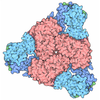[English] 日本語
 Yorodumi
Yorodumi- PDB-2qgf: Structure of regulatory chain mutant H20A of asparate transcarbam... -
+ Open data
Open data
- Basic information
Basic information
| Entry | Database: PDB / ID: 2qgf | ||||||
|---|---|---|---|---|---|---|---|
| Title | Structure of regulatory chain mutant H20A of asparate transcarbamoylase from E. coli | ||||||
 Components Components |
| ||||||
 Keywords Keywords | TRANSFERASE/Transferase regulator / allosteric enzyme regulatory chain mutation / heterotropic regulation / TRANSFERASE-Transferase regulator COMPLEX | ||||||
| Function / homology |  Function and homology information Function and homology information aspartate carbamoyltransferase complex / pyrimidine nucleotide biosynthetic process / aspartate carbamoyltransferase complex / pyrimidine nucleotide biosynthetic process /  aspartate carbamoyltransferase / aspartate carbamoyltransferase /  aspartate carbamoyltransferase activity / aspartate carbamoyltransferase activity /  amino acid binding / glutamine metabolic process / protein homotrimerization / 'de novo' UMP biosynthetic process / 'de novo' pyrimidine nucleobase biosynthetic process / zinc ion binding ... amino acid binding / glutamine metabolic process / protein homotrimerization / 'de novo' UMP biosynthetic process / 'de novo' pyrimidine nucleobase biosynthetic process / zinc ion binding ... aspartate carbamoyltransferase complex / pyrimidine nucleotide biosynthetic process / aspartate carbamoyltransferase complex / pyrimidine nucleotide biosynthetic process /  aspartate carbamoyltransferase / aspartate carbamoyltransferase /  aspartate carbamoyltransferase activity / aspartate carbamoyltransferase activity /  amino acid binding / glutamine metabolic process / protein homotrimerization / 'de novo' UMP biosynthetic process / 'de novo' pyrimidine nucleobase biosynthetic process / zinc ion binding / identical protein binding / amino acid binding / glutamine metabolic process / protein homotrimerization / 'de novo' UMP biosynthetic process / 'de novo' pyrimidine nucleobase biosynthetic process / zinc ion binding / identical protein binding /  cytosol / cytosol /  cytoplasm cytoplasmSimilarity search - Function | ||||||
| Biological species |   Escherichia coli (E. coli) Escherichia coli (E. coli) | ||||||
| Method |  X-RAY DIFFRACTION / X-RAY DIFFRACTION /  MOLECULAR REPLACEMENT / Resolution: 2.2 Å MOLECULAR REPLACEMENT / Resolution: 2.2 Å | ||||||
 Authors Authors | Stec, B. / Williams, M.K. / Stieglitz, K.A. / Kantrowitz, E.R. | ||||||
 Citation Citation |  Journal: Acta Crystallogr.,Sect.D / Year: 2007 Journal: Acta Crystallogr.,Sect.D / Year: 2007Title: Comparison of two T-state structures of regulatory-chain mutants of Escherichia coli aspartate transcarbamoylase suggests that His20 and Asp19 modulate the response to heterotropic effectors. Authors: Stec, B. / Williams, M.K. / Stieglitz, K.A. / Kantrowitz, E.R. | ||||||
| History |
|
- Structure visualization
Structure visualization
| Structure viewer | Molecule:  Molmil Molmil Jmol/JSmol Jmol/JSmol |
|---|
- Downloads & links
Downloads & links
- Download
Download
| PDBx/mmCIF format |  2qgf.cif.gz 2qgf.cif.gz | 197.7 KB | Display |  PDBx/mmCIF format PDBx/mmCIF format |
|---|---|---|---|---|
| PDB format |  pdb2qgf.ent.gz pdb2qgf.ent.gz | 158.2 KB | Display |  PDB format PDB format |
| PDBx/mmJSON format |  2qgf.json.gz 2qgf.json.gz | Tree view |  PDBx/mmJSON format PDBx/mmJSON format | |
| Others |  Other downloads Other downloads |
-Validation report
| Arichive directory |  https://data.pdbj.org/pub/pdb/validation_reports/qg/2qgf https://data.pdbj.org/pub/pdb/validation_reports/qg/2qgf ftp://data.pdbj.org/pub/pdb/validation_reports/qg/2qgf ftp://data.pdbj.org/pub/pdb/validation_reports/qg/2qgf | HTTPS FTP |
|---|
-Related structure data
| Related structure data | 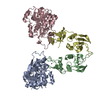 2qg9C  1nbeS C: citing same article ( S: Starting model for refinement |
|---|---|
| Similar structure data |
- Links
Links
- Assembly
Assembly
| Deposited unit | 
| ||||||||
|---|---|---|---|---|---|---|---|---|---|
| 1 | 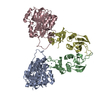
| ||||||||
| Unit cell |
| ||||||||
| Components on special symmetry positions |
|
- Components
Components
| #1: Protein | Mass: 34337.105 Da / Num. of mol.: 2 Source method: isolated from a genetically manipulated source Source: (gene. exp.)   Escherichia coli (E. coli) / Strain: EK1104 / Gene: pyrB / Plasmid: pEK121 / Production host: Escherichia coli (E. coli) / Strain: EK1104 / Gene: pyrB / Plasmid: pEK121 / Production host:   Escherichia coli (E. coli) / References: UniProt: P0A786, Escherichia coli (E. coli) / References: UniProt: P0A786,  aspartate carbamoyltransferase aspartate carbamoyltransferase#2: Protein | Mass: 17076.557 Da / Num. of mol.: 2 / Mutation: H20A Source method: isolated from a genetically manipulated source Source: (gene. exp.)   Escherichia coli (E. coli) / Gene: pyrI / Plasmid: pEK121 / Production host: Escherichia coli (E. coli) / Gene: pyrI / Plasmid: pEK121 / Production host:   Escherichia coli (E. coli) / References: UniProt: P0A7F3 Escherichia coli (E. coli) / References: UniProt: P0A7F3#3: Chemical | #4: Water | ChemComp-HOH / |  Water Water |
|---|
-Experimental details
-Experiment
| Experiment | Method:  X-RAY DIFFRACTION / Number of used crystals: 1 X-RAY DIFFRACTION / Number of used crystals: 1 |
|---|
- Sample preparation
Sample preparation
| Crystal | Density Matthews: 2.99 Å3/Da / Density % sol: 58.86 % |
|---|---|
Crystal grow | Temperature: 298 K / Method: microdialysis / pH: 5.7 Details: 0.1M citric acid, pH 5.7, MICRODIALYSIS, temperature 298.0K |
-Data collection
| Diffraction | Mean temperature: 298 K |
|---|---|
| Diffraction source | Source:  ROTATING ANODE / Type: RIGAKU RU200 / Wavelength: 1.5418 Å ROTATING ANODE / Type: RIGAKU RU200 / Wavelength: 1.5418 Å |
| Detector | Type: UCSD MARK II / Detector: AREA DETECTOR / Date: Nov 18, 1996 |
| Radiation | Monochromator: GRAPHITE / Protocol: SINGLE WAVELENGTH / Monochromatic (M) / Laue (L): M / Scattering type: x-ray |
| Radiation wavelength | Wavelength : 1.5418 Å / Relative weight: 1 : 1.5418 Å / Relative weight: 1 |
| Reflection | Resolution: 2.2→35 Å / Num. all: 59318 / Num. obs: 59318 / Observed criterion σ(F): 0 / Observed criterion σ(I): 0 / Redundancy: 3.3 % / Rmerge(I) obs: 0.099 |
- Processing
Processing
| Software |
| |||||||||||||||||||||
|---|---|---|---|---|---|---|---|---|---|---|---|---|---|---|---|---|---|---|---|---|---|---|
| Refinement | Method to determine structure : :  MOLECULAR REPLACEMENT MOLECULAR REPLACEMENTStarting model: 1NBE Resolution: 2.2→35 Å / Cross valid method: THROUGHOUT / σ(F): 0 / σ(I): 0 / Stereochemistry target values: Engh & Huber
| |||||||||||||||||||||
| Refinement step | Cycle: LAST / Resolution: 2.2→35 Å
| |||||||||||||||||||||
| Refine LS restraints |
|
 Movie
Movie Controller
Controller


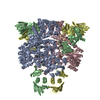

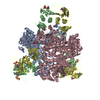
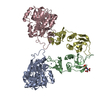

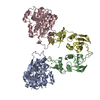
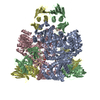


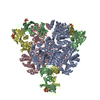
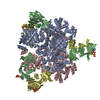
 PDBj
PDBj